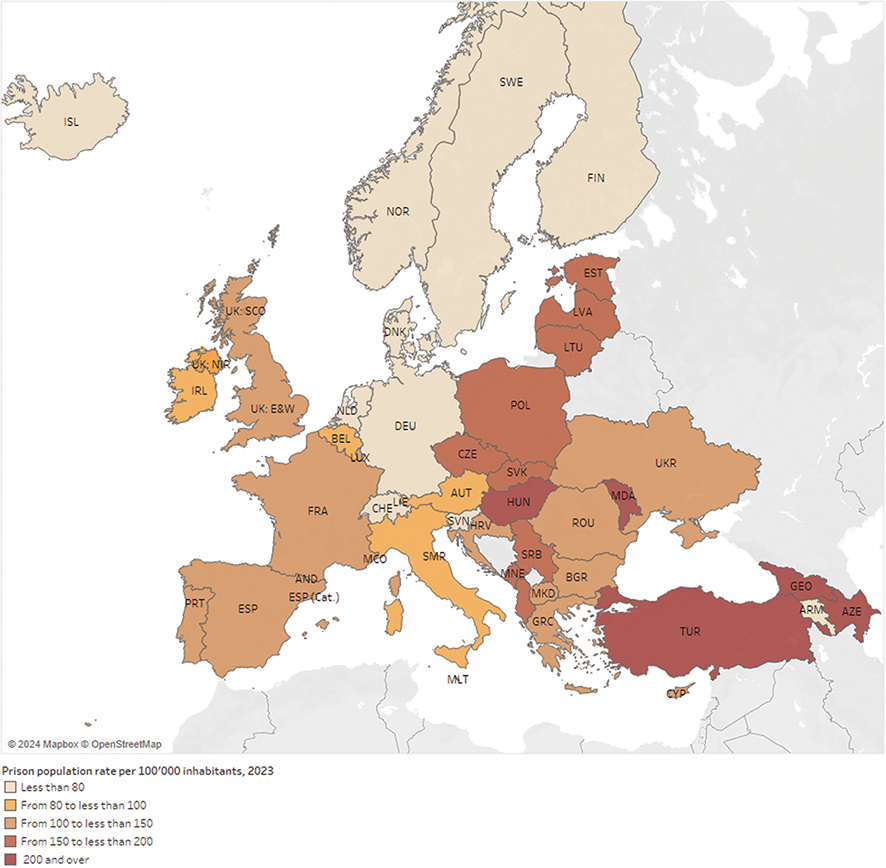On June 6, the Council of Europe shared its report, ‘Prisons and Prisoners in Europe 2023: Key Findings of the SPACE I survey,’ authored by Marcelo F. Aebi & Edoardo Cocco. The report summarizes key findings from the 2023 Council of Europe Annual Penal Statistics on Prison Populations, better known as SPACE I, an acronym derived from its French name, Statistiques Pénales Annuelles du Conseil de l’Europe. A total of 48 out of the 51 prison administrations across the 46 Council of Europe member states responded to the 2023 SPACE I questionnaire, contributing to this year’s survey, signifying a 94% participation rate. The sole administrations that refrained from replying were those of Bosnia and Herzegovina, specifically the State PA, the Federation of Bosnia and Herzegovina PA, and the Republika Srpska PA.
The report serves as a crucial resource for policymakers, advocates, and stakeholders in Georgia and across Europe, highlighting areas for targeted intervention and reform within the criminal justice system.
On 31 January 2023, there were 1,036,680 inmates in the 48 prison administrations of Council of Europe member states that participated in the SPACE I survey.
Significant variations in prison population rates can be observed across regions. Generally, countries in Eastern Europe and the Caucasus region, including Azerbaijan, Georgia, and Türkiye, exhibit considerably elevated prison population rates compared to their Western and Northern European counterparts. On the other end of the spectrum, countries such as Germany, the Netherlands, Slovenia, Switzerland, and the Nordic nations report remarkably low prison population rates.
The countries reporting the highest inmate-to-staff ratios, such as Türkiye and Georgia, also have the highest prison population rates. Conversely, several countries with the lowest ratios, including the Netherlands, Norway, and Denmark, are also among those with the lowest prison population rates.
Here’s a focused look at the findings concerning Georgia. Note that prison data for Georgia exclude territories that are not under government control.

Prison Population
As of January 31, 2023, Georgia reported a prison population of 256 inmates per 100,000 inhabitants, marking it as among the countries with the highest incarceration rates.
While Georgia’s figures are notable, it is essential to acknowledge the broader context. Comparatively, countries in Eastern Europe and the Caucasus, including Georgia, have significantly higher prison population rates than their Western and Northern European counterparts.
Incarceration Trends
The SPACE I survey notes a concerning trend of increasing incarceration rates in Georgia, alongside other countries like the Republic of Moldova and North Macedonia.
Georgia appeared second in the list, after Türkiye, of countries with the highest incarceration rates, at 256 per 100,000 inhabitants.
Despite efforts in some nations to stabilize or reduce prison population rates, Georgia’s rates have risen by 8.2%.
The average age of inmates in Georgia’s penal institutions is 44.
Georgia has 82 inmates per 100 available places.
Georgia is among the countries with the lowest percentage of women inmates (3.4%).
Among the countries with high prison population rates, Georgia’s percentage of inmates serving sentences under 6 months is less than 1%.
Pre-trial Detainees
Approximately one-third of inmates in European prisons are in pre-trial detention. In Georgia, the proportion of pre-trial detainees is notable, indicating challenges within the legal system regarding detainment before trial.
Offences
Drug-related offences remain prevalent among prisoners, constituting 18.5% of the prison population in the surveyed countries. In Georgia, as in other countries such as Latvia and Azerbaijan, over a quarter of all inmates are convicted for drug-related offences. The survey of the 48 countries that participated notes this is followed by homicide or attempted homicide (12.8%), theft (11.5%), robbery (7.7%), assault and battery (6.7%), sexual offences excluding rape (4.6%), rape (4.3%), economic or financial crimes (3%) and road traffic offences (3%).
Overall Assessment
Georgia’s penal statistics reflect broader regional trends of high incarceration rates and significant proportions of pre-trial detainees and drug-related offences.
These findings underscore the importance of continued efforts to address issues within the justice system, promote alternative sentencing measures, and address underlying social and economic factors contributing to crime and incarceration.
By Katie Ruth Davies














